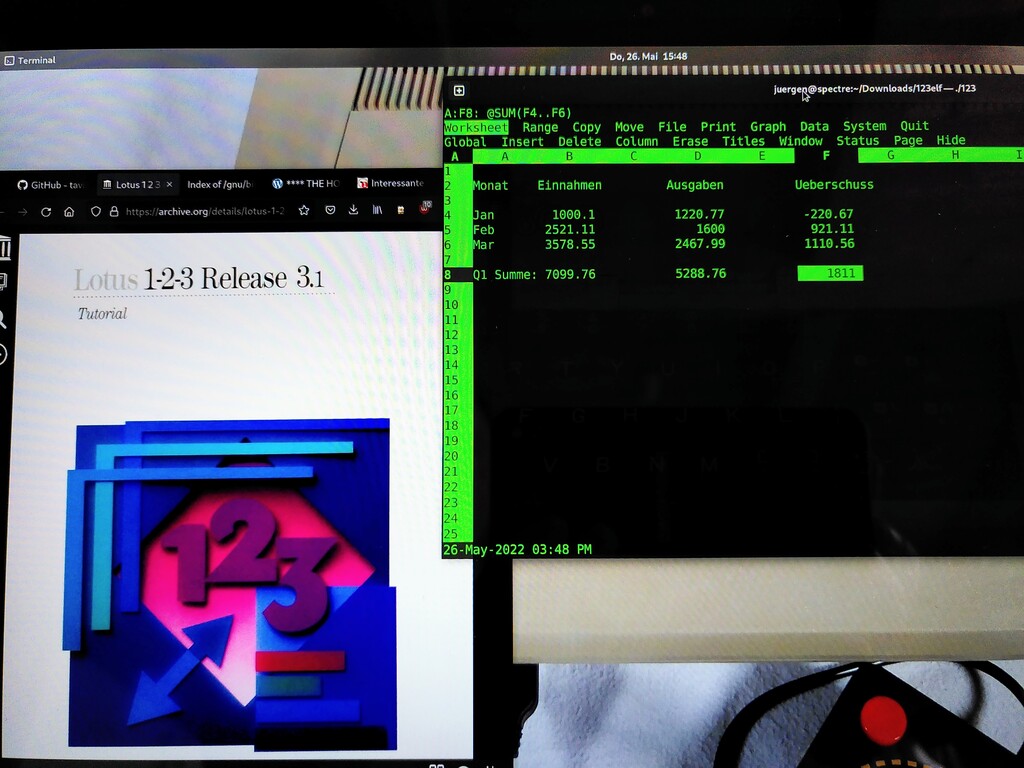Wer wir sind
Die Adressen unserer Website sind: https://www.homecomputerguy.de, https://homecomputerguy.de, https://www.retroguy.de, https://retroguy.de.
Welche personenbezogenen Daten wir sammeln und warum wir sie sammeln
Kommentare
Wenn Besucher Kommentare auf der Website schreiben, sammeln wir die Daten, die im Kommentar-Formular angezeigt werden, außerdem die IP-Adresse des Besuchers und den User-Agent-String (damit wird der Browser identifiziert), um die Erkennung von Spam zu unterstützen.
Aus deiner E-Mail-Adresse kann eine anonymisierte Zeichenfolge erstellt (auch Hash genannt) und dem Gravatar-Dienst übergeben werden, um zu prüfen, ob du diesen benutzt. Die Datenschutzerklärung des Gravatar-Dienstes findest du hier: https://automattic.com/privacy/. Nachdem dein Kommentar freigegeben wurde, ist dein Profilbild öffentlich im Kontext deines Kommentars sichtbar.
Medien
Wenn du ein registrierter Benutzer bist und Fotos auf diese Website lädst, solltest du vermeiden, Fotos mit einem EXIF-GPS-Standort hochzuladen. Besucher dieser Website könnten Fotos, die auf dieser Website gespeichert sind, herunterladen und deren Standort-Informationen extrahieren.
Kontaktformulare
Cookies
Wenn du einen Kommentar auf unserer Website schreibst, kann das eine Einwilligung sein, deinen Namen, E-Mail-Adresse und Website in Cookies zu speichern. Dies ist eine Komfortfunktion, damit du nicht, wenn du einen weiteren Kommentar schreibst, all diese Daten erneut eingeben musst. Diese Cookies werden ein Jahr lang gespeichert.
Falls du ein Konto hast und dich auf dieser Website anmeldest, werden wir ein temporäres Cookie setzen, um festzustellen, ob dein Browser Cookies akzeptiert. Dieses Cookie enthält keine personenbezogenen Daten und wird verworfen, wenn du deinen Browser schließt.
Wenn du dich anmeldest, werden wir einige Cookies einrichten, um deine Anmeldeinformationen und Anzeigeoptionen zu speichern. Anmelde-Cookies verfallen nach zwei Tagen und Cookies für die Anzeigeoptionen nach einem Jahr. Falls du bei der Anmeldung „Angemeldet bleiben“ auswählst, wird deine Anmeldung zwei Wochen lang aufrechterhalten. Mit der Abmeldung aus deinem Konto werden die Anmelde-Cookies gelöscht.
Wenn du einen Artikel bearbeitest oder veröffentlichst, wird ein zusätzlicher Cookie in deinem Browser gespeichert. Dieser Cookie enthält keine personenbezogenen Daten und verweist nur auf die Beitrags-ID des Artikels, den du gerade bearbeitet hast. Der Cookie verfällt nach einem Tag.
Eingebettete Inhalte von anderen Websites
Beiträge auf dieser Website können eingebettete Inhalte beinhalten (z. B. Videos, Bilder, Beiträge etc.). Eingebettete Inhalte von anderen Websites verhalten sich exakt so, als ob der Besucher die andere Website besucht hätte.
Diese Websites können Daten über dich sammeln, Cookies benutzen, zusätzliche Tracking-Dienste von Dritten einbetten und deine Interaktion mit diesem eingebetteten Inhalt aufzeichnen, inklusive deiner Interaktion mit dem eingebetteten Inhalt, falls du ein Konto hast und auf dieser Website angemeldet bist.
Analysedienste
Mit wem wir deine Daten teilen
Wie lange wir deine Daten speichern
Wenn du einen Kommentar schreibst, wird dieser inklusive Metadaten zeitlich unbegrenzt gespeichert. Auf diese Art können wir Folgekommentare automatisch erkennen und freigeben, anstelle sie in einer Moderations-Warteschlange festzuhalten.
Für Benutzer, die sich auf unserer Website registrieren, speichern wir zusätzlich die persönlichen Informationen, die sie in ihren Benutzerprofilen angeben. Alle Benutzer können jederzeit ihre persönlichen Informationen einsehen, verändern oder löschen (der Benutzername kann nicht verändert werden). Administratoren der Website können diese Informationen ebenfalls einsehen und verändern.
Welche Rechte du an deinen Daten hast
Wenn du ein Konto auf dieser Website besitzt oder Kommentare geschrieben hast, kannst du einen Export deiner personenbezogenen Daten bei uns anfordern, inklusive aller Daten, die du uns mitgeteilt hast. Darüber hinaus kannst du die Löschung aller personenbezogenen Daten, die wir von dir gespeichert haben, anfordern. Dies umfasst nicht die Daten, die wir aufgrund administrativer, rechtlicher oder sicherheitsrelevanter Notwendigkeiten aufbewahren müssen.
Wohin wir deine Daten senden
Besucher-Kommentare könnten von einem automatisierten Dienst zur Spam-Erkennung untersucht werden.
Folgende WordPress-Funktionen sind aktiviert und verwenden Daten wie folgt beschrieben
Activity
This feature only records activities of a site’s registered users, and the retention duration of activity data will depend on the site’s plan and activity type.
Data Used: To deliver this functionality and record activities around site management, the following information is captured: user email address, user role, user login, user display name, WordPress.com and local user IDs, the activity to be recorded, the WordPress.com-connected site ID of the site on which the activity takes place, the site’s Jetpack version, and the timestamp of the activity. Some activities may also include the actor’s IP address (login attempts, for example) and user agent.
Activity Tracked: Login attempts/actions, post and page update and publish actions, comment/pingback submission and management actions, plugin and theme management actions, widget updates, user management actions, and the modification of other various site settings and options. Retention duration of activity data depends on the site’s plan and activity type. See the complete list of currently-recorded activities (along with retention information).
Data Synced (?): Successful and failed login attempts, which will include the actor’s IP address and user agent.
Carousel
Image views are only recorded if the site owner, has explicitly enabled image view stats tracking for this feature via the jetpack_enable_carousel_stats filter.
Data Used: If image view tracking is enabled, the following information is used: IP address, WordPress.com user ID (if logged in), WordPress.com username (if logged in), user agent, visiting URL, referring URL, timestamp of event, browser language, country code.
Activity Tracked: Image views.
Comment Likes
This feature is only accessible to users logged in to WordPress.com.
Data Used: In order to process a comment like, the following information is used: WordPress.com user ID/username (you must be logged in to use this feature), the local site-specific user ID (if the user is signed in to the site on which the like occurred), and a true/false data point that tells us if the user liked a specific comment. If you perform a like action from one of our mobile apps, some additional information is used to track the activity: IP address, user agent, timestamp of event, blog ID, browser language, country code, and device info.
Activity Tracked: Comment likes.
Contact Form
Data Used: If Akismet is enabled on the site, the contact form submission data — IP address, user agent, name, email address, website, and message — is submitted to the Akismet service (also owned by Automattic) for the sole purpose of spam checking. The actual submission data is stored in the database of the site on which it was submitted and is emailed directly to the owner of the form (i.e. the site author who published the page on which the contact form resides). This email will include the submitter’s IP address, timestamp, name, email address, website, and message.
Data Synced (?): Post and post meta data associated with a user’s contact form submission. If Akismet is enabled on the site, the IP address and user agent originally submitted with the comment are synced, as well, as they are stored in post meta.
GIF Block
Data Used: An iframe is inserted into the page, using an HTTP connection. The iframe is governed by Giphy’s privacy policy.
Activity Tracked: We don’t track any activity. For details of what Giphy tracks, refer to their privacy policy.
Gravatar Hovercards
Data Used: This feature will send a hash of the user’s email address (if logged in to the site or WordPress.com — or if they submitted a comment on the site using their email address that is attached to an active Gravatar profile) to the Gravatar service (also owned by Automattic) in order to retrieve their profile image.
Infinite Scroll
Data Used: In order to record page views via WordPress.com Stats (which must be enabled for page view tracking here to work) with additional loads, the following information is used: IP address, WordPress.com user ID (if logged in), WordPress.com username (if logged in), user agent, visiting URL, referring URL, timestamp of event, browser language, country code.
Activity Tracked: Page views will be tracked with each additional load (i.e. when you scroll down to the bottom of the page and a new set of posts loads automatically). If the site owner has enabled Google Analytics to work with this feature, a page view event will also be sent to the appropriate Google Analytics account with each additional load.
Jetpack Comments
Data Used: Commenter’s name, email address, and site URL (if provided via the comment form), timestamp, and IP address. Additionally, a jetpack.wordpress.com IFrame receives the following data: WordPress.com blog ID attached to the site, ID of the post on which the comment is being submitted, commenter’s local user ID (if available), commenter’s local username (if available), commenter’s site URL (if available), MD5 hash of the commenter’s email address (if available), and the comment content. If Akismet (also owned by Automattic) is enabled on the site, the following information is sent to the service for the sole purpose of spam checking: commenter’s name, email address, site URL, IP address, and user agent.
Activity Tracked: The comment author’s name, email address, and site URL (if provided during the comment submission) are stored in cookies. Learn more about these cookies.
Data Synced (?): All data and metadata (see above) associated with comments. This includes the status of the comment and, if Akismet is enabled on the site, whether or not it was classified as spam by Akismet.
Likes
This feature is only accessible to users logged in to WordPress.com.
Data Used: In order to process a post like action, the following information is used: IP address, WordPress.com user ID, WordPress.com username, WordPress.com-connected site ID (on which the post was liked), post ID (of the post that was liked), user agent, timestamp of event, browser language, country code.
Activity Tracked: Post likes.
Map Block
Activity Tracked: We don’t track anything. Refer to the Mapbox privacy policy for details of any activity they track.
Mobile Theme
Data Used: A visitor’s preference on viewing the mobile version of a site.
Activity Tracked: A cookie (akm_mobile) is stored for 3.5 days to remember whether or not a visitor of the site wishes to view its mobile version. Learn more about this cookie.
Notifications
This feature is only accessible to registered users of the site who are logged in to WordPress.com.
Data Used: IP address, WordPress.com user ID, WordPress.com username, WordPress.com-connected site ID and URL, Jetpack version, user agent, visiting URL, referring URL, timestamp of event, browser language, country code. Some visitor-related information or activity may be sent to the site owner via this feature. This may include: email address, WordPress.com username, site URL, email address, comment content, follow actions, etc.
Activity Tracked: Sending notifications (i.e. when we send a notification to a particular user), opening notifications (i.e. when a user opens a notification that they receive), performing an action from within the notification panel (e.g. liking a comment or marking a comment as spam), and clicking on any link from within the notification panel/interface.
Pinterest Block
Data Used: A pin is embedded using JavaScript resources loaded from Pinterest directly.
Activity Tracked: We don’t track any activity. For details of what Pinterest tracks, refer to their privacy policy.
Protect
Data Used: In order to check login activity and potentially block fraudulent attempts, the following information is used: attempting user’s IP address, attempting user’s email address/username (i.e. according to the value they were attempting to use during the login process), and all IP-related HTTP headers attached to the attempting user.
Activity Tracked: Failed login attempts (these include IP address and user agent). We also set a cookie (jpp_math_pass) for 1 day to remember if/when a user has successfully completed a math captcha to prove that they’re a real human. Learn more about this cookie.
Data Synced (?): Failed login attempts, which contain the user’s IP address, attempted username or email address, and user agent information.
Sharing
Data Used: When official sharing buttons are active on the site, each button loads content directly from its service in order to display the button as well as information and tools for the sharing party. As a result, each service can in turn collect information about the sharing party. When a non-official Facebook or a Pinterest sharing button is active on the site, information such as the sharing party’s IP address as well as the page URL will be available for each service, so sharing counts can be displayed next to the button. When sharing content via email (this option is only available if Akismet is active on the site), the following information is used: sharing party’s name and email address (if the user is logged in, this information will be pulled directly from their account), IP address (for spam checking), user agent (for spam checking), and email body/content. This content will be sent to Akismet (also owned by Automattic) so that a spam check can be performed. Additionally, if reCAPTCHA (by Google) is enabled by the site owner, the sharing party’s IP address will be shared with that service. You can find Google’s privacy policy here.
Subscriptions
Data Used: To initiate and process subscriptions, the following information is used: subscriber’s email address and the ID of the post or comment (depending on the specific subscription being processed). In the event of a new subscription being initiated, we also collect some basic server data, including all of the subscribing user’s HTTP request headers, the IP address from which the subscribing user is viewing the page, and the URI which was given in order to access the page (REQUEST_URI and DOCUMENT_URI). This server data used for the exclusive purpose of monitoring and preventing abuse and spam.
Activity Tracked: Functionality cookies are set for a duration of 347 days to remember a visitor’s blog and post subscription choices if, in fact, they have an active subscription.
Data Used: IP address, WordPress.com user ID (if
logged in), WordPress.com username (if logged in), user agent, visiting
URL, referring URL, timestamp of event, browser language, country code. Important: The site owner does not
have access to any of this information via this feature. For example, a
site owner can see that a specific post has 285 views, but he/she
cannot see which specific users/accounts viewed that post. Stats logs —
containing visitor IP addresses and WordPress.com usernames (if
available) — are retained by Automattic for 28 days and are used for the sole purpose of powering this feature.
Activity Tracked: Post and page views, video plays
(if videos are hosted by WordPress.com), outbound link clicks,
referring URLs and search engine terms, and country. When this module is
enabled, Jetpack also tracks performance on each page load that
includes the JavaScript file used for tracking stats. This is
exclusively for aggregate performance tracking across Jetpack sites in
order to make sure that our plugin and code is not causing performance
issues. This includes the tracking of page load times and resource
loading duration (image files, JavaScript files, CSS files, etc.). The
site owner has the ability to force this feature to honor DNT settings of visitors. By default, DNT is currently not honored.






